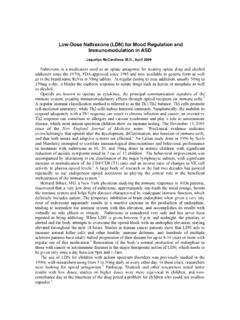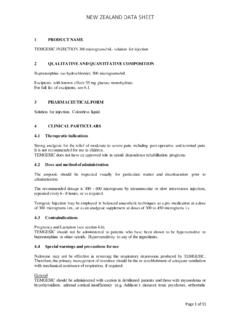Transcription of NEW ZEALAND DATA SHEET 1. - Medsafe Home Page
1 Page 1 of 10 NEW ZEALAND DATA SHEET 1. methadone INJECTION BP 10 mg/mL solution for injection methadone Injection BP 10 mg/mL solution for injection. 2. QUALITATIVE AND QUANTITATIVE COMPOSITION Each mL contains 10 mg of methadone hydrochloride. For the full list of excipients, see section 3. PHARMACEUTICAL FORM Solution for injection. Clear, colourless solution with a pH of 4. CLINICAL PARTICULARS Therapeutic indications methadone Injection is used as an analgesic for the relief of moderate to severe pain. Single doses of methadone have a less marked sedative action than morphine. dose and method of administration dose methadone Injection should be administered in the smallest effective dose in order to minimize development of tolerance and physical dependence.
2 The usual adult dosage is mg every 3-4 hours as necessary. The analgesic effect begins about 15 minutes after subcutaneous injection. In patients with severe, chronic pain dosage should be adjusted according to the severity of the pain and the response and tolerance of the patient. In patients with exceptionally severe, chronic pain or in those that have become tolerant to the analgesic effects of opiate agonists, it may be necessary to exceed the usual dosage. Special populations Hepatic impairment Hepatic dysfunction does not unduly affect methadone metabolism, and dosage of methadone need not be changed in stable chronic liver disease. However, abrupt changes in hepatic status might result in substantial alterations in methadone disposition requiring dosage adjustments.
3 Page 2 of 10 Renal impairment Urinary excretion of methadone is reduced in renal failure, but plasma concentration remain within the usual range and faecal elimination accounts for the majority of the dose . Very little methadone is removed by dialysis. Elderly Dosage should be reduced in elderly or debilitated patients. Paediatric population Use in children is not recommended as there has been insufficient clinical experience to establish a dosage regimen. A paediatric analgesic dosage of mg/kg daily given in divided doses every 4-6 hours has been suggested, but dosage should be carefully individualised. Method of administration Subcutaneous or intramuscular injection. If repeated injections are required, the intramuscular route is preferred to the subcutaneous.
4 methadone is considerably more lipid soluble than morphine more rapid and greater relief of pain may be achieved if it is injected into the deltoid rather than the gluteal muscle. Contraindications methadone is contraindicated in respiratory depression and obstructive airways disease. It is also contraindicated, or should be used with great caution, in acute alcoholism, convulsive disorders, head injuries and conditions in which intracranial pressure is raised. methadone should not be given to comatose patients. methadone Injection should not be used for obstetric analgesia, as the drug's long duration of effect may increase the risk of neonatal respiratory depression. Special warnings and precautions for use This medicine should not be used for the treatment of chronic pain of non-malignant origin unless all other conservative methods of analgesia have been tried and have failed and there is no psychological contraindication, drug seeking behaviour or history of drug misuse.
5 Therapy should only be initiated by a specialist with experience in chronic pain management and in accordance with guidelines approved by the New ZEALAND Medical Association. methadone should be given with caution or in reduced doses to patients with hypothyroidism, adrenocortical insufficiency, asthma, impaired kidney or liver function, prostatic hyperplasia, hypotension, shock, inflammatory or obstructive bowel disorders or myasthenia 3 of 10 Discontinuation of therapy with methadone should be carried out gradually in patients who may have developed physical dependence to the drug in order to avoid precipitating withdrawal symptoms. methadone should be given with great care to infants, especially neonates. Cardiac conduction effects Laboratory studies, both in vivo and in vitro, have demonstrated that methadone inhibits cardiac potassium channels and prolongs the QT interval.
6 Cases of QT interval prolongation and serious arrhythmia (torsades de pointes) have been observed during treatment with methadone . These cases appear to be more commonly associated with, but not limited to, higher dose treatment (>100 mg/day). Most cases involve patients being treated for pain with large, multiple daily doses of methadone although cases have been reported in patients receiving doses commonly used for maintenance treatment of opioid addiction. methadone should be administered with particular caution to patients already at risk for development of prolonged QT interval. These risks include cardiac hypertrophy, history of cardiac conduction abnormalities, advanced heart disease or ischaemic heart disease, liver disease, family history of sudden death, hypokalaemia, hypomagnesaemia, concomitant treatments with medicines that have a potential for QT prolongation, concomitant treatment with medicines which may cause electrolyte abnormalities ( diuretics), and concomitant treatment with CYP3A4 inhibitors.
7 QT prolongation has also been reported in patients with no prior cardiac history who have received high doses of methadone . Patients developing QT prolongation while on methadone treatment should be evaluated for the presence of modifiable risk factors, such as concomitant medications with cardiac effects, drugs which might cause electrolyte abnormalities, and drugs which might act as inhibitors of methadone metabolism. In patients with recognised risk factors of QT prolongation, or in case of concomitant treatment with medicines that have a potential for QT prolongation, ECG monitoring is recommended prior to methadone treatment, at dose stabilisation, after dose increases, or after starting any potentially interacting medicine.
8 In patients without recognised risk factors for QT prolongation, ECG monitoring is recommended before dose titration above 100 mg/day, and at seven days after titration. For use of methadone to treat pain, the risk of QT prolongation and development of dysrhythmias should be weighed against the benefit of adequate pain management and the availability of alternative therapies. Concomitant use with benzodiazepines or other CNS depressants Profound sedation, respiratory depression, coma, and death may result from the concomitant use of methadone Injection with benzodiazepines or other CNS depressants ( , non-benzodiazepine sedatives/hypnotics, anxiolytics, tranquilizers, muscle relaxants, general anaesthetics, medicines with antihistamine-sedating actions such as antipsychotics, other opioids, alcohol).
9 Because of these risks, Page 4 of 10 reserve concomitant prescribing of these drugs for use in patients for whom alternative treatment options are inadequate. Observational studies have demonstrated that concomitant use of opioid analgesics and benzodiazepines increases the risk of medicine-related mortality compared to use of opioid analgesics alone. Because of similar pharmacological properties, it is reasonable to expect similar risk with the concomitant use of other CNS depressant drugs with opioid analgesics (see section ). If the decision is made to prescribe a benzodiazepine or other CNS depressant concomitantly with an opioid analgesic, prescribe the lowest effective dosages and minimum durations of concomitant use.
10 In patients already receiving an opioid analgesic, prescribe a lower initial dose of the benzodiazepine or other CNS depressant than indicated in the absence of an opioid, and titrate based on clinical response. If an opioid analgesic is initiated in a patient already taking a benzodiazepine or other CNS depressant, prescribe a lower initial dose of the opioid analgesic, and titrate based on clinical response. Follow patients closely for signs and symptoms of respiratory depression and sedation. Advise both patients and caregivers about the risks of respiratory depression and sedation when methadone Injection is used with benzodiazepines or other CNS depressants (including alcohol and illicit drugs). Advise patients not to drive or operate heavy machinery until the effects of concomitant use of the benzodiazepine or other CNS depressant have been determined.














